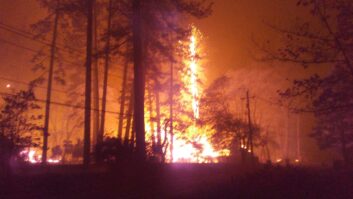Question: When the FCC considers a radio station’s application to move to a different location, what evidence would suffice to demonstrate that the proposed spot is a “licensable community”?
Is it enough that the area — let’s call it Horse Creek — is named on a map? That the licensee can show photos of a local elementary school, post office and fire station? That there is a Horse Creek Cattle Company Stone House and Ranch at the spot?
This question isn’t just academic. The FCC has just rejected an application from KLLM(FM) in Wheatland, Wyo., owned by Michael Radio Co., to relocate its transmitter to a new site and change its community of license to Horse Creek, an unincorporated area closer to populous Laramie.
But White Park Broadcasting, which owns several stations of its own in Wyoming, filed an informal objection. It said Horse Creek is not a licensable community for allotment purposes.
Now the commission has agreed. It also issued a general public reminder to applicants regarding the types of online photos and other images often used as documentation in such cases.
The timeline
Michael Radio Co. originally had asked to change KLLM’s community of license to West Laramie, about 60 miles southwest of its current market of Wheatland. After the FCC sent a deficiency letter questioning whether West Laramie constituted a community for its allotment purposes, Michael amended its application to change to Laramie itself. But the FCC said retaining a fourth local service at Wheatland would be preferred over an 11th local service for Laramie.
In August Michael again amended the application, specifying Horse Creek, about 20 miles outside of Laramie.
It told the FCC that this move would provide a first local service there, and it provided materials to make its case that Horse Creek is a community.
According to the FCC summary, the evidence included a screenshot of the Wikipedia web page for Horse Creek; a topographical map marked Horse Creek; a photo of Clawson Elementary School; screenshots containing demographic information for the local Zip code; a photo titled “Horse Creek Post Office and Store;” screenshots of a Facebook page titled “Horse Creek; Wyoming”; a Google Maps photo of the Horse Creek Fire Station; a sign for the Horse Creek Campground in Shoshone National Forest; a screenshot of a Facebook page for the Horse Creek Honey food stand in Cheyenne; and Facebook and Google Maps photos of Horse Creek Cattle Company Stone House and Ranch (“described as a rental venue for weddings, business retreats and family vacations,” according to the commission summary).

But in its objection to the application, White Park argued that the elementary school is merely part of a regional school system serving all of Laramie County; that the fire station is not a local organization; and that the businesses bearing the “Horse Creek” name do not have physical locations in Horse Creek.
It compared Horse Creek to West Laramie which, in 2010, the bureau ruled was not a licensable community. As White Park sees it, “There are absolutely no civic, cultural, religious, social or commercial entities in Horse Creek that serve to create any form of community.” It argued that if Horse Creek is deemed a community, “the commission will have eviscerated the allotment standards … and opened itself up to an unlimited number of allotment modification submissions.”
Michael defended its proposal by saying that incorporation is not a prerequisite for community status; that Horse Creek is a geographic location used by mapping, weather and real estate services; and that though Horse Creek provides no government services, its fire station and school are in the community, with Horse Creek addresses, and are intended for use by residents and businesses of Horse Creek.
[See Our Business and Law Page]
The ruling
White Park prevailed.
“We find that Horse Creek is not a licensable community for allotment purposes,” Audio Division Chief Albert Shuldiner has ruled.
His order walks the reader through the determination process.
“If a locale is not either incorporated or listed in the U.S. Census, the proponent of an allotment must show that it is a ‘geographically identifiable population grouping.’ The principal test for this is whether the ‘residents function as and conceive of themselves a community around which their interests coalesce.’”
He said this may be demonstrated by testimony of residents and/or other “indicia of community.” Factors that are frequently considered are whether the community is marked on a published map; whether it has a post office that offers residential service; whether it provides municipal services such as education, police and fire protection; whether it would more logically be considered part of another, more established, community; whether it supports commercial activity; and whether its name is used on businesses and other organizations.
“The test to determine whether a specific location qualifies as a community … is a liberal one and takes into account the totality of the circumstances,” Shuldiner wrote.
Horse Creek is not incorporated or listed with the U.S. Census, and Michael didn’t provide statements from residents. So Shuldiner looked at map data, post office and Zip code information, governmental services and other parameters.
He agreed that Horse Creek is a physical place, based on the map data and the county fire authority. “Nonetheless, it is well established that a mere geographic location is insufficient to establish community status.”
While Michael claimed that there is a federal post office in Horse Creek, Shuldiner said that the post office closed in 2017 and that residents of Horse Creek now get their mail at a cluster box by vehicle from Cheyenne.
“Although the 82061 Zip code area is designated as Horse Creek,” he continued, “this fact is of minimal value as an indicator of community status. As a routing tool used by the federal mail delivery system, a Zip code area may straddle towns, counties and even states.”
He noted that the elementary school and fire protection services are provided by a much larger county. In fact, “it appears that Horse Creek provides no governmental services at all.” And its minimal level of commercial activity does not support a finding of community status.
Taking all of that into account, Shuldiner rejected Michael’s application to change the stations community of license — “with no further opportunity for corrective amendment.”
Take care with pix
Shuldiner added: “We take this opportunity to caution applicants regarding the use of materials obtained exclusively from online sources.”
If an applicant to the Audio Division wants to use a website or information obtained online such as photographs, he said, it should make every reasonable effort to verify or authenticate the information provided.
This might include, for example, “making a site visit to the community it proposes to serve, obtaining a statement from an individual with personal knowledge of the facts alleged, or at the very least corroborating the information using another reliable online source. Importantly, any website used to support an application must be clearly identified with the site owner or publisher, title of the page, URL address, last date visited, and any other relevant information. If reviewing staff cannot identify or verify a submission, it will be excluded from our community status determination.”
Also, he said, petitioners and applicants must use the most recent 2020 U.S. Census data available when determining a community’s population in addition to the population served and overlap of service areas to communities and Urbanized Areas.












